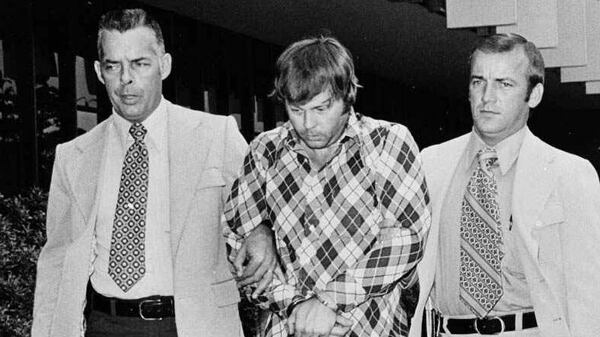Patricia Almazan lost her father in a mass shooting at a California library more than three decades ago and knows all too well the pain felt by those who lost loved ones in the movie theater massacre in Colorado.

Almazan learned about that agony as she held her father’s hand in an Orange County hospital emergency room in July 1976. She squeezed and felt him squeeze back, and she was sure he was trying to tell her something, but in the next moment he succumbed to his wounds.
Almazan still feels the hurt of that loss. She prays that the grieving souls in Aurora, Colo., at least are spared the added torment she faced after the custodian at the Cal State Fullerton library who killed her father and six others was found not guilty by reason of insanity. A case that began with cops and courts was passed to doctors and hospitals.
“Doctors—whose job it is to get him well and get back in society,” Almazan says. “You don’t want that if you’re a victim.”
By every indication, the only defense James Holmes can possibly mount in Colorado is an insanity plea. Some local attorneys believe he might even prevail, especially if he was diagnosed as schizophrenic before the massacre. A man named Bruco Eastwood, who shot two students outside a suburban Denver middle school in 2011, and might have perpetrated a massacre had he not been tackled by heroic teachers, was found not guilty by reason of insanity, in part because of a notebook filled with rantings.
Nobody believes a gunman from a case as notorious as the movie theater massacre would ever be released, no matter what proves to be in James Holmes’s notebook, but anyone found not guilty by reason of insanity in Colorado is entitled to an annual release hearing just like those accorded in California. And Almazan has learned from the hearings granted her father’s killer that even the slightest possibility that the person who inflicted such hurt might walk free can translate into agony for the survivors.
For Almazan, it has meant a quarter-century of fighting to make absolutely sure that the library custodian, Edward Charles Allaway, never just ambles back among us after calmly killing person after person with a semi-automatic rifle that he then neatly wrapped in a blanket and placed in the back of his car. Allaway pleaded not guilty by reason of insanity and the jury deadlocked. The retrial was before only a judge, who found Allaway had indeed been insane in the legal sense at the time of the killings.
After a decade in the secure mental-health facility in Atascadero, Calif., Allaway announced that he was well enough to be released and treated as an outpatient. He told an Orange County court during two hours of testimony that he felt deeply sorry for his crimes.
“It’s not fair to keep me locked up,” he said. “I am no longer mentally ill, in the sense I’m a danger to myself or to others.”
Allaway noted that many people with mental illness function well in society.
“Yes, but they don’t kill a bunch of people,” Almazan said loudly enough for the judge to chide her.
Allaway’s case suffered a setback when a psychologist he called to testify on his behalf told the court that he was only in remission, had declined to take part in various treatment programs, and could still constitute a danger.
“A psychotic episode could recur if he were released back into the community,” said the psychologist, Douglas Coggins.
Almazan counted it as a victory when Allaway’s petition was denied. She then learned that he had been transferred to a less secure facility anyway. State mental-health officials said the move had been “inadvertent” and he was returned to Atascadero.
In 1992, Allaway tried again. A psychiatrist testified at the release hearing that Allaway was in “full remission.” The judge said he was on the verge of freeing Allaway and ordered him transferred to Napa State Hospital, just 50 miles from Almazan’s home. Almazan made her outrage known.
“I said, ‘He’s mass murderer!’” she recalled.
The state mental-health officials said they had recommended that Allaway “be transferred for preparation for community placement” but insisted he had not yet been given a “grounds privilege card” that would have allowed him to roam the unfenced area unsupervised. He was again returned to Atascadero.
In 2001, Allaway once more applied for release, announcing that he had been “completely cured.” He was by then in a secure wing at Patton State Hospital, whose administrators said in a letter to the court: “Mr. Allaway would benefit from a carefully developed and individualized discharge plan. The clinical staff are of the opinion that Mr. Allaway would no longer be a danger to the health and safety of others, including himself, while under supervision and treatment in the community.”
The hearing lasted seven weeks. Almazan sat through it all, using her summer vacation. She says: “I made sure I was there and everybody knew why I was there. We couldn’t set a precedent of letting loose a mass murderer. You’d be surprised how hard a victim has to fight.”
Allaway testified for nine hours. He said that during the shooting he had hallucinated that he was fleeing behind the woman he had shot in the back. He said that when he called the police after he fled the scene, he thought he was a victim.
“I was beaten up and I wanted to press charges,” he said. ‘I didn’t know I did the shooting.”
Allaway insisted that at present, “the last thing I want to do is hurt anybody.” He said he had prepared for release by taking a lesson in using an ATM machine.
“You want to be normal,” he testified, adding, “I would like to have a good relationship with a woman.”
The experts remained doubtful, noting that only between 10 and 20 percent of schizophrenics show any significant recovery over time. They deemed a cure was exceedingly rare, and they were all the more dubious in Allaway’s case, as he had long since stopped taking medication.
In the end, the judge denied Allaway’s petition. Allaway appealed, but that was denied and he remained at Patton State Hospital. He continued to receive disability payments from the state though he insisted he was no longer disabled.
Almazan says that a reporter from the Orange County Register had been urging her to sit down with Allaway, but she refused.
“I didn’t think he would tell the truth,” she recalls.
She then heard a rumor that the killer had cancer. She wondered if that might make him more forthcoming.
“There was just a slight glimmer in my mind that maybe he would open up to me,” she says.
She and her firefighter husband, Joe Almazan, met with Allaway and the reporter in what she calls “a tiny room in a very tiny trailer” at Patton State.
“I really don’t have a whole lot of answers,” Allaway told her. “I was insane at the time, and when you’re insane, there’s just not a good reason or rhyme how things work out.”
“Why did you shoot my dad three times in the back?” she asked.
“I have no idea,” Allaway replied. “I don’t remember hurting those people—killing them.”
She at one point showed him a photograph of her father, Frank Teplansky, a former Marine who served in World War II and Korea and was a talented graphic artist at Cal State, as well as a wonderful pianist and an amateur magician who delighted his grandsons by pulling quarters from their ears. The supposedly cured killer looked at the photo and appeared to have no reaction at all.
“He didn’t respond to it,” Almazan recalls. “It didn’t mean anything to him. Nothing.”
In 2010, Almazan learned that Patton State had written a letter to an outpatient program reporting that Allaway was “symptom free.” Prosecutors from the Orange County district attorney’s office joined her protest. The killer stayed where he was, keeping company with David Attias, who was found not guilty by reason of insanity after he killed four people in 2002 by driving his car into a crowd in Santa Barbara. He had leapt from the car announcing, “I am the angel of death.”
Attias, the 30-year-old son of TV director Daniel Attias, is presently seeking release to a community outpatient program. A hearing was conducted earlier this year, and the judge’s decision is pending.
In the meanwhile Attias spends his days with Allaway, who now 74 and not likely ever to be released, if Almazan can help it. She is as passionate as ever, though she is now 66.
“He darn well knows I’m still alive,” she says of Allaway. “For the years I’ve been involved I could teach psychiatry now.”
She allows she does not rank Allaway among the most cold-blooded of killers.
“For some reason I don’t,” she says, then adding, “I’m so against what he did, I can’t personally forgive him. That’s God’s job.”
The pain of her loss is still clear in her voice when she speaks of her father and his service to his country, his magic tricks, and that final squeeze of the hand he gave in answer to her own.
She retains a belief in the power of prayer, and she is putting that to work with the hope the grieving folks in Colorado do not have to spend the years ahead going from one release hearing to another. She notes that the survivors of Columbine and Virginia Tech were spared that ordeal.
“Fortunately, many mass murderers kill themselves,” she says.
She suggests that our focus should be on finding ways to recognize the warning signals before a madman picks up a gun.
“We need to do something as a nation,” she says. “To really train people to read the signs.”




